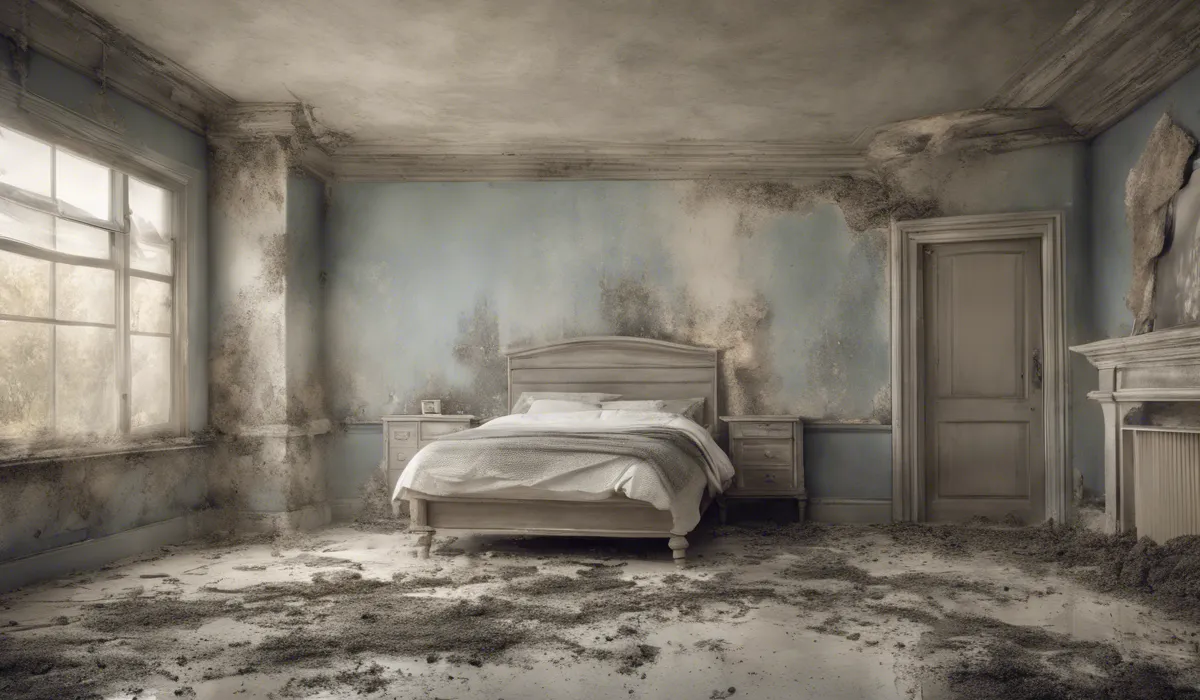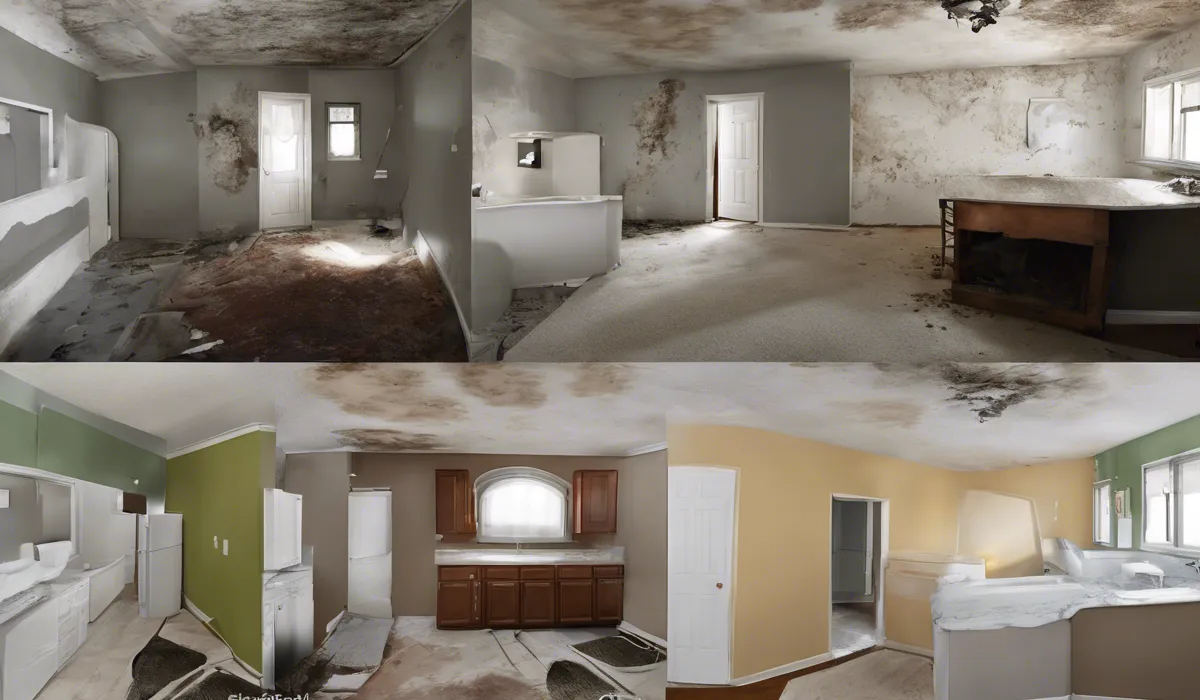To find hidden mold in your house, inspect areas prone to moisture like behind drywall, under carpets, and in ductwork. Use a flashlight to check dark spaces and consider a mold test kit for uncertain spots.
Understanding Mold and Its Common Hiding Places

What Mold Is and Why It’s a Problem?
Mold is a type of fungus that can grow both indoors and outdoors. It spreads by releasing tiny spores into the air, which can be harmful when inhaled.
Mold is a problem because it can cause health issues, especially for people with allergies, asthma, or weak immune systems.
It can also damage your home by breaking down materials like wood and drywall. Getting rid of mold is important to keep your family healthy and your home safe.
Typical Characteristics of Mold Growth
Mold loves damp, dark, and warm places. It often looks like a stain and comes in colors like black, green, or white. Mold can also have a fuzzy appearance.
It grows best where there is moisture, so any leaks or condensation can lead to mold growth. Recognizing these characteristics helps you spot mold early before it becomes a bigger problem.
Common Areas Where Mold Tends to Hide
Bathrooms and Kitchens
Mold often grows in bathrooms and kitchens because these areas have a lot of moisture. Check under sinks, around faucets, and any place where water is used often.
Be sure to look in hidden spots, like under the kitchen sink or behind the toilet. Keeping these areas dry and clean is key to preventing mold.
Basements, Attics, and Crawl Spaces
These places are common for mold because they are not always well-ventilated and can be damp. Look for signs of water damage or leaks.
Basements and crawl spaces should have good drainage to avoid standing water. In attics, make sure insulation is dry and there are no roof leaks.
Behind Walls and Wallpaper
Walls can hide mold growth, especially if there’s been water damage. Peeling or bubbling wallpaper can indicate mold is present.
If you suspect mold behind walls, it might be time to call a professional because this can be tricky to check on your own.
Under Carpets and Floorboards
Carpets can trap moisture, leading to mold underneath. If a carpet feels damp or smells musty, there might be mold.
Floorboards can also hide mold, especially if there’s been a spill or leak that wasn’t cleaned up properly.
Around Window Frames
Windows can collect condensation, which may lead to mold growth. Check the corners and sills of your windows, especially if they’re old or not well-sealed.
Keeping windows dry is important to stop mold from starting.
In HVAC Systems
Your heating, ventilation, and air conditioning system can be a hotspot for mold. The ductwork can collect dust and moisture, making it a perfect place for mold to grow.
Have your HVAC system checked and cleaned regularly to prevent mold.
Inside Appliances
Appliances that use water, like washing machines, can also harbor mold. Check for standing water or leaks, and clean and dry these appliances often to keep mold away.
Detection Methods for Hidden Mold

Visual Inspection Tips
When looking for mold, use a flashlight to check dark corners and hidden spaces. Look for discoloration, warping, or water stains.
Sometimes mold hides in plain sight, so be thorough and inspect all areas of your home.
Using Your Sense of Smell to Detect Musty Odors
Mold often has a musty, earthy smell. If you notice an odd smell in your home, especially in areas where there’s been water damage, there might be mold.
Trust your nose, and if something smells off, it’s worth investigating further.
Moisture Detection Tools
Moisture Meters
These tools can tell you how much moisture is in your walls, floors, and ceilings. High moisture levels can indicate a risk for mold. Use a moisture meter to help find potential mold hotspots.
Infrared Cameras
Infrared cameras can show you cool spots in your home, which might mean there’s moisture.
This can help you find hidden leaks that could lead to mold growth. These cameras are a high-tech way to spot trouble areas you can’t see with the naked eye.
Professional Mold Testing
Air Sampling
Professionals can take samples of the air in your home to check for mold spores. This can tell you if you have mold, even if you can’t see it.
Air sampling is a good idea if someone in your home has allergies or other health issues.
Surface Sampling
This method involves taking samples from surfaces to see if mold is growing. It can confirm if a suspicious spot is actually mold.
Surface sampling can also identify the type of mold, which is helpful for treatment.
Bulk Sampling
Bulk sampling means taking a piece of material from your home to test for mold. This is a direct way to check for mold in carpets, walls, or insulation.
Bulk sampling should be done by professionals to avoid spreading mold spores.
DIY Mold Testing Kits
You can buy mold testing kits to use at home. They usually involve collecting samples and sending them off to a lab for analysis.
These kits can be a first step in detecting mold, but if you get a positive result, it’s best to call in a professional for a more thorough inspection.
Prevention and Remediation Strategies

Controlling Humidity and Moisture Levels in Your Home
Keeping your home dry is the best way to prevent mold. Use exhaust fans in bathrooms and kitchens to remove moisture.
Fix leaks as soon as you find them. Use a dehumidifier if you live in a humid climate, and make sure your home has good drainage.
Proper Ventilation Techniques
Fresh air helps keep moisture down, which prevents mold. Open windows when you can, and use fans to keep air moving.
Make sure your clothes dryer vents outside, and check your attic and crawl spaces to ensure they have proper ventilation.
Regular Cleaning and Maintenance Routines
Clean your home often to prevent mold. Pay special attention to bathrooms and kitchens, where mold likes to grow.
Check your home for leaks and water damage regularly, and take care of any problems right away. Staying on top of maintenance can save you from mold headaches later.
When to Call a Professional for Mold Remediation?
If you find a lot of mold, or if the mold is in hard-to-reach places, it’s best to call a professional.
They have the tools and knowledge to safely remove mold and fix the problem that caused it.
If anyone in your home has health issues, don’t try to remove mold yourself. Safety first!
Steps for Safe Mold Removal for Small Areas
If you have a small area of mold, you might be able to clean it yourself. Wear gloves and a mask, and use soap and water or a mold-cleaning product.
Be sure to dry the area well after cleaning to prevent the mold from coming back.
Long-Term Prevention Strategies
Use of Dehumidifiers and Air Purifiers
Dehumidifiers can help keep your home dry, which is good for stopping mold. Air purifiers can reduce mold spores in the air. These tools are especially helpful in damp or poorly-ventilated areas of your home.
Mold-Resistant Products and Materials for Home Repairs and Renovations
When fixing or upgrading your home, choose mold-resistant materials like paints, drywall, and insulation. These products can help prevent mold from growing, even if there’s moisture.
Regular Inspections of Potential Problem Areas
Check areas where mold could grow, like under sinks and around windows, often. Catching mold early can make it easier to clean and keep your home healthy.
Remember, the best way to fight mold is to prevent it from growing in the first place.
FAQs About Finding Hidden Mold in Your House
What are common signs that indicate hidden mold in the house?
Common signs of hidden mold include a musty smell, discoloration on walls or ceilings, and persistent health symptoms like allergies or respiratory issues when indoors.
How can I inspect for mold behind drywall in my home?
To inspect for mold behind drywall, look for visible signs of moisture damage or use a moisture meter to detect abnormal moisture levels, which can indicate the presence of mold.
What steps should I take to check for mold under carpets?
Carefully peel back a section of the carpet to inspect for mold on the underside or the subfloor, especially in areas where spills have occurred or moisture is common.
How do I examine ductwork for hidden mold?
Inspect the ductwork by removing vent covers and using a flashlight to look for mold growth inside the ducts. If you suspect mold, consider having a professional HVAC technician perform a thorough inspection.
Is it advisable to use a mold test kit, and how effective are they?
Mold test kits can be helpful for identifying the presence of mold in uncertain spots, but their effectiveness varies. It’s advisable to follow up with professional testing for more accurate results.
Final Thoughts
To uncover hidden mold, vigilantly inspect moisture-prone areas such as behind drywall, beneath carpets, and within ductwork.
A flashlight is essential for examining dark recesses. For areas where mold presence is uncertain, employing a mold test kit can confirm suspicions and help ensure your home remains safe and healthy.
